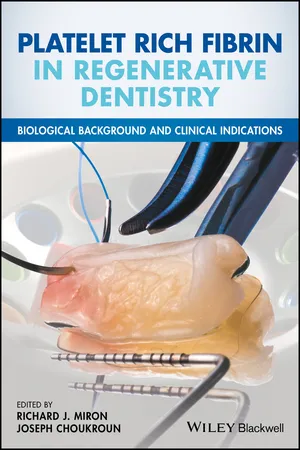
Platelet Rich Fibrin in Regenerative Dentistry
Biological Background and Clinical Indications
- English
- ePUB (mobile friendly)
- Available on iOS & Android
Platelet Rich Fibrin in Regenerative Dentistry
Biological Background and Clinical Indications
About This Book
The first book devoted exclusively to the subject, Platelet Rich Fibrin in Regenerative Dentistry offers comprehensive, evidence-based coverage of the biological basis and clinical applications of PRF in dentistry. Co-edited by a leading researcher in tissue regeneration and the inventor of the PRF technique, it brings together original contributions from expert international researchers and clinicians.
Chapters cover the biological foundation of PRF before addressing specific uses of the technology within clinical dentistry. Topics describe the use of PRF in many dental applications, including extraction socket management, sinus lifting procedures, root coverage, periodontal regeneration, soft tissue healing around implants, guided bone regeneration, and facial esthetics. The text is supplemented with color photographs and explanatory illustrations throughout.
Platelet Rich Fibrin in Regenerative Dentistry: Biological Background and Clinical Indications is an indispensable professional resource for periodontists, oral surgeons and oral and maxillofacial surgeons, as well as general dentists who use PRF or are interested in introducing it into their practices. It is also an excellent reference for undergraduate and postgraduate dental students.
Frequently asked questions
Information
1
Platelet Rich Fibrin: A Second-Generation Platelet Concentrate
AbstractAlmost two decades have passed since platelet rich fibrin (PRF) was first introduced. Initially, the primary objective was to develop a therapy where platelet concentrates could be introduced into wounds by effectively utilizing the body's natural healing capacity. This was achieved by collecting growth factors derived from blood in a natural way. Platelet rich plasma (PRP) and platelet rich growth factor (PRGF) had been commercialized, yet both contained secondary byproducts that were both unnatural and known inhibitors of wound healing. By removing these anti-coagulants and modifying centrifugation protocols, PRF was introduced some years later with the potential to markedly impact many fields of medicine including dentistry. Many aspects important for tissue regeneration have since been revealed including the important role of fibrin as well as the preferential release of growth factors over longer periods of time from PRF. Furthermore, by introducing a new set of cells into platelet concentrates (namely leukocytes), a marked impact on tissue regeneration and wound healing was observed. Over the past 5 years, further modifications to centrifugation speed and time have additionally improved PRF into a concept now known as the “low-speed centrifugation concept.” Investigators began to modify surgical techniques to favorably treat patients with PRF with improved clinical outcomes. Together, many key opinion leaders from around the globe have been gathered to share their experiences and knowledge in many educational courses and seminars in what we now know as platelet rich fibrin. In this first chapter, we highlight the discovery of PRF and the studies leading to its first use in regenerative medicine. We focus specifically on its properties for wound healing and how its presented advantages over previous versions of platelet concentrates have favorably enhanced the regenerative potential of platelet concentrates in dentistry.
Highlights
- Introduction of Platelet Rich Fibrin
- Reasons for its invention two decades ago
- Its variations from the formally known platelet concentrate “platelet rich plasma” or “PRP”
- The first case treated with PRF
- Properties important for wound healing
1.1 Introduction
1.2 Brief history of platelet concentrates
Table of contents
- Cover
- Title Page
- Copyright Page
- Dedcation
- About the Authors
- Foreword
- Preface
- 1 Platelet Rich Fibrin: A Second-Generation Platelet Concentrate
- 2 Biological Components of Platelet Rich Fibrin: Growth Factor Release and Cellular Activity
- 3 Introducing the Low-Speed Centrifugation Concept
- 4 Uses of Platelet Rich Fibrin in Regenerative Dentistry: An Overview
- 5 Use of Platelet Rich Fibrin for the Management of Extraction Sockets: Biological Basis and Clinical Relevance
- 6 Maxillary Sinus Floor Elevation in the Atrophic Posterior Maxillae: Anatomy, Principles, Techniques, Outcomes, and Complications
- 7 Maxillary Sinus Floor Elevation Procedures with Platelet Rich Fibrin: Indications and Clinical Recommendations
- 8 Use of Platelet Rich Fibrin for the Treatment of Muco-Gingival Recessions: Novel Improvements in Plastic Aesthetic Surgery Utilizing The Fibrin Assisted Soft Tissue Promotion (FASTP) Technique
- 9 Use of Platelet Rich Fibrin for Periodontal Regeneration/Repair of Intrabony and Furcation Defects
- 10 Platelet Rich Fibrin as an Adjunct to Implant Dentistry
- 11 Guided Bone Regeneration with Platelet Rich Fibrin
- 12 Modern Approach to Full Arch Immediate Loading: The Simonpieri Technique with PRF and i-PRF
- 13 Use of Platelet Rich Fibrin in Facial Aesthetics and Rejuvenation
- 14 Use of Platelet Rich Fibrin in Other Areas of Medicine
- 15 Future Research with Platelet Rich Fibrin
- Index
- EULA